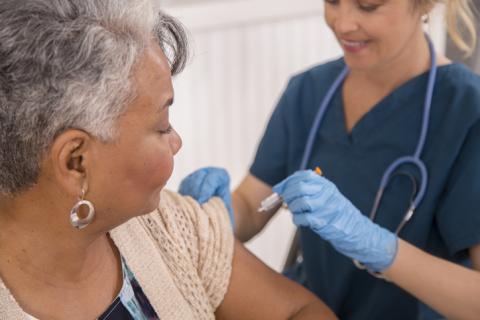Flu shots this winter providing moderate levels of protection, CDC data show
Interim estimates from the Centers for Disease Control and Prevention indicate the vaccine offers about 47 percent protection against all influenza infections and 46 percent protection against H1N1 viruses, which are causing the lion’s share of illnesses this year in most parts of the United States. The protection rate against H3N2 viruses, which are the main culprits in the southeastern U.S., is 44 percent.
That means, in rough terms, that for every 10 flu infections in people who were not vaccinated, four or five would have been averted if they’d taken a flu shot. The findings were published in the CDC’s online journal Morbidity and Mortality Weekly Report.
The estimates are actually lower than what has been reported in Canada and Hong Kong this winter. Canada reported 72 percent effectiveness in all age groups against H1N1 viruses, while a study from Hong Kong — which looked solely on children — suggested the vaccine was 90 percent protective overall, and the H1N1 component was 92 percent effective in preventing serious illness.
But Dr. Alicia Fry, head of epidemiology and prevention in the CDC’s Influenza Branch, cautioned against drawing too many comparisons at this point in the flu season. The season has been mild, Fry said, and there have been fewer infections than last year. That means there are less data on which to calculate the interim estimate.
Fry called the signs of effectiveness so far “encouraging” and said the level of protection provided by the vaccine is within the range of what one would expect during a flu season when H1N1 viruses predominate.
It’s also an improvement over last year, when the mid-season estimate of how the vaccine was working showed that about three-quarters of people who got a flu shot were not protected against H3N2 viruses, which were causing the most illness last year.
Dr. Edward Belongia, director of the Center for Clinical Epidemiology and Population Health at Wisconsin’s Marshfield Clinic, agreed that the estimates so far for this season are in the expected range.
“This is sort of in the general ballpark of what we’ve seen overall,” said Belongia, who runs one of the study sites that gathers data for the CDC’s annual effort to monitor flu vaccine effectiveness.
The U.S. data so far suggest better H1N1 protection in children 17 and younger; the rate in that group was 62 percent.
But the effectiveness in older adults was low — 24 percent overall and only 8 percent against H1N1 viruses in people 50 and older. Neither of those numbers was statistically significant, meaning the possibility that there was no protection in that age group can’t be ruled out.
Again, Fry urged caution, noting that researchers saw so few infections in older adults that it’s really too early to say how the vaccine is working in this group this year. Normally the CDC would give an estimate of how the vaccine performed in people 65 and older, one of the most vulnerable age groups when it comes to influenza infections, but the authors of this report were not able to do so.
“We had so few [cases] in the 65 and older that we couldn’t even come up with an estimate,” Fry said.
They will be watching closely to see how well the vaccine works in this group as the flu season progressed, she stressed.
In the 2015-2016 season, low vaccine effectiveness in younger adults signaled that the H1N1 strain in the vaccine wasn’t triggering production of the right kinds of antibodies in that age group. The vaccine strain was updated after that.
Scott Hensley’s laboratory at the University of Pennsylvania spotted that problem after the 2015-2016 season. And Hensley, an associate professor of microbiology, was interested to see the low effectiveness in older adults reported by the CDC for this season. But he said it might be explained by a lack of available data for older adults.
“Obviously, if those numbers pan out to be true, then it will be very interesting and worthwhile to try to figure out why there was this reduced effectiveness in that group,” he said.
The CDC on Thursday also released data providing some estimates of how onerous this flu season has been so far.
Even though it has been mild, the CDC estimates that between 9,600 and 15,900 people died from influenza-associated causes between Oct. 1 and Feb. 2. The agency estimate that as many as 15 million people may have been infected and more than 7 million may have sought medical care for influenza, with between 155,000 and 186,000 of those people ending up in hospital because of the flu.
Of the 26 pediatric deaths reported in the period of study, the median age of the children who died was 6.5 years old. Just under half of these children had another health problem that increased their risk of developing a severe infection if they contracted influenza.
Vaccination status was known for 22 of the children. Only three of them were fully vaccinated against flu. Children under the age of 9 who have never been vaccinated against influenza before need two doses of flu vaccine.
